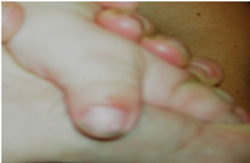What is Pfeiffer syndrome?
Also known as: Acrocephalosyndactyly–Pfeiffer–type
Pfeiffer syndrome is a genetic disorder characterized by early fusion of the bones of the skull (craniosynostosis). This in turn leads to abnormalities of the head and face. The disease is present at birth, and symptoms can persist and worsen as a person ages. The annual incidence of Pfeiffer syndrome is around one in every 100,000 births.
Pfeiffer syndrome was first described in 1964 by Dr. Rudolph Arthur Pfeiffer. This condition is also called acrocephalosyndactyly –Pfeiffer type which means “tall” head with variable fusion of the fingers.
What are the signs/symptoms of Pfeiffer Syndrome?
Pfeiffer syndrome has been divided into three clinical categories based on the clinical features found in the affected individual:
Type 1
- Craniosynostosis (premature closure of the skull sutures)
- Broad thumbs and great toes with variable fusion of bone/skin of fingers (syndactyly)
- Normal/near normal intelligence
Type 2
- Cloverleaf shaped skull due to craniosynostosis of multiple sutures.
- Severe ocular proptosis (protruding eyes)
- Broad thumbs and great toes
- Central nervous system anomalies
- Limited extension of elbow
Type 3
- Similar to type 2 without cloverleaf shaped skull

Reviewed by: Chad A Perlyn, MD
This page was last updated on: 1/29/2019 3:21:13 PM
© 2025 Nicklaus Children's Hospital. All Rights Reserved.